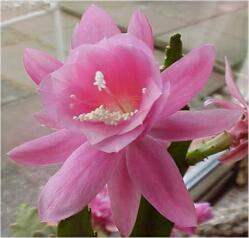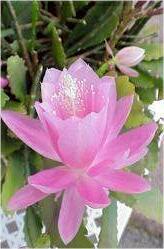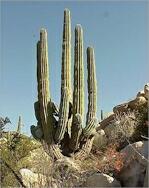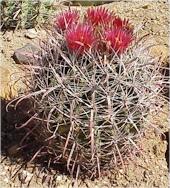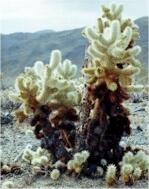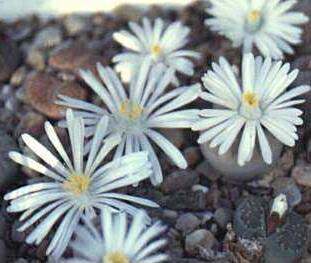|
This page presents an overview of the cacti and other succulent plants. It describes their main features, how they are adapted to live in dry environments, and some of their main ecological roles. For "profiles" of more than 25 different cacti and cactus types, go to the Cactus Gallery. To see how cacti are integrated with other components of desert communities, go to The North American Deserts Gallery. The cactus family The cactus family (Cactaceae) contains about 2,500 species, all of which (with one possible exception) are found naturally only in the Americas (North, Central and South America, and the Caribbean Islands). The one exception is the genus Rhipsalis which grows naturally in Sri Lanka, Madagascar and East Africa, but it might have been introduced into those regions at some time in history or might have arrived there by chance. In more recent times, cacti have been introduced into other countries. The most notable example is the prickly pear (Opuntia) which was introduced into Australia and then spread to become a major poblem in rangelands. But we can be confident that the cacti are truly natives of the Americas, where this family of plants evolved and diverged from other types of flowering plant along time ago, because the Cactaceae is not closely related to any other plant family. All plant families are defined by the details of their flower parts. In the case of cacti, the flowers have many petals that intergrade with sepals, so that the two are not easily distinguished. The flowers also have many stamens (male parts that have the pollen-bearing anthers) and a stigma (female flower part) that has several lobes. Those are the defining features of a cactus, shown in the images below, even though they are not the features that first come to mind when we think of a cactus.
Flowers of an ornamental variety of the cactus Epiphyllum, showing the many-lobed stigma and the many stamens.
Adaptations for drought tolerance Cacti are classic examples of plants that have evolved, apparently from tropical ancestors, to grow in environments where water is scarce for large parts of the year. They have swollen stems which contain water-storage tissues, and the stems have a thick waterproof epidermis, usually covered with a waxy cuticle to help prevent water loss. Plants of this type are termed stem succulents. The cacti typically have extensive root systems, spreading just below the soil surface, so that they can absorb even the relatively small amounts of water that moisten the soil surface during light showers of rain. To help them store water in times of plenty, the stems of many cacti are fluted, with ribs so that the stem can expand and contract without damage to the surface tissues. Cacti also have evolved to use the stems as the main photosynthetic organs, for synthesizing sugars, rather than using leaves. In fact, most cacti do not produce leaves at all. The main exceptions are the species of Opuntia (prickly pears and chollas), which have rudimentary leaves in their juvenile stages. But even these leaves are cylindrical and fleshy, adapted to withstand some water loss, and they are shed in drought conditions.
In place of leaves, cacti have special organs called areoles. These are like buds and they are arranged regularly along the ribs of the stem or on the tips of tubercles (see images below). They produce spines which help to protect the stems from being eaten by herbivores. In some cacti the spines are so dense that they almost completely obscure the underlying stems, shielding the stems from intense sunlight and preventing the plant from overheating. Range of form, and convergent evolution Even though we can instantly recognise most cacti as being cacti, they show a wide range of forms, each adapted to particular environmental and site conditions. For example, the large columnar cacti such as the saguaro and the cardon cactus are conspicuous and dominant plants in desert regions that experience relatively high rainfall (up to about 30 cm precipitation each year). These cacti contrast with the many smaller forms - often 5 - 15 cm tall - which are found in drier conditions. One of the most unusual of these is the living rock cactus of the Chihuahuan Desert (see image above). This cactus grows as a rosette of triangular, spine-less tubercles on arid limestone ledges, and stores both water and nutrients in a rather deep, turnip-like taproot. It blends perfectly with the limestone rock fragments of its habitat, so it is difficult to see - perhaps an adaptation to protect it from herbivores. Much of the range of form of cacti can be seen by going to the Cactus Gallery. Some other plants, quite unrelated to cacti, are stem succulents that have evolved features resembling those of cacti in order to cope with similar environmental conditions - a process termed convergent evolution. Chief among these plants are the African species of Euphorbia (the spurge family: Euphorbiaceae). For example, the image on the left below shows three plants, but only the plant on the extreme left is a cactus - the "old man" cactus of the Sonoran Desert. The other two plants are Euphorbia species from Africa. The third of these plants even has thorns (see the close-up image on the right) but they are not like the spines of cacti. When we look at the flowers it becomes obvious that they are in a different family - the flower structure is typical of Euphorbiaceae.
Several other large plant families have developed fleshy, succulent leaves to cope with periodic drought conditions, and they bear a superficial resemblance to cacti. These plants are called leaf succulents, rather than stem succulents. One of them is the mesembryanthemum family, and it includes the remarkable living stone plants (Lithops species) of the South African and Namibian Deserts (images below). These plants characteristically grow among pebbles on the banks of dry river beds, where they are perfectly comouflaged and where they receive periodic water when the river beds fill after rains. Each plant consists of a pair of fleshy leaves, exposed only at the surface, where the photosynthetic tissues are located beneath the patterned "windows" (see Living stones). They produce white or yellow daisy-like flowers in summer, then the old pair of leaves shrivels while the water and nutrients within them are absorbed by a new pair of leaves (or occasionally two pairs) which emerge from the gap between the old leaves.
Another major family of leaf succulents - the Crassulaceae - are commonly known as the stonecrops. These are rosette-forming plants, which are not necessarily confined to desert regions - they even occur on rocky outcrops in cool parts of the world, including Britain. Physiological adaptations to drought conditions Plants that grow in dry environments face a major problem. In order to grow, they need to absorb carbon dioxide from the atmosphere and convert it into sugars (photosynthesis) by using energy obtained from light. Plants gain their carbon dioxide by opening small pores, called stomata on the leaf or stem surface. But opening of the stomata during the hot, daytime hours leads to loss of water from the tissues. The cacti and many other succulent plants have overcome this dilemma by using a special biochemical process called crassulacean acid metabolism (CAM) because it was first discovered in plants of the Crassulaceae family. Details of this can be found on another page, but basically these plants open their stomata by night, when the temperature is cool, and absorb carbon dioxide which they store by chemically combining it with an organic compound containing 3 carbon atoms, producing a 4-carbon organic acid. During the day, when the stomata are closed, the carbon dioxide is released from this organic acid and used to synthesize sugars, using the energy of light. These plants do exactly the opposite of normal plants, which open their stomata by day when light is available for photosynthesis, and close them at night. Some other plants of hot environments have developed a further physiological adaptation, called C4 metabolism, which contrasts with the C3 metabolism of most plants. This is found especially in many tropical and subtropical grasses, including those of the warmer deserts of North America. Details can be found on a separate page. Cacti as integral components of natural habitats Cacti may be fascinating organisms, but the question we will ask here is: how important are they as members of the desert community? How do they fit into the whole scene? The answer is that some of the larger cacti can be major components of the desert vegetation, and provide food and shelter for other organisms. The large cacti support a range of animals such as the specialised cactus bees (which use cactus pollen to feed their larvae), javelinas which each large amounts of prickly pear pads, and bats which depend on the nectar of cardon, saguaro and organ pipe cactus during their annual northern migration from southern Mexico into northern Mexico and Arizona. Fruits of the larger cacti provide food for many birds, while the plants themselves provide shelter and nest sites for woodpeckers and flickers, cactus wrens, curve-billed thrashers, owls and hawks, etc. Without these large cacti, there would be significantly less animal diversity. But the largest cacti are confined to the smi-tropical environment of the Sonoran Desert of North America and, apart from the chollas and prickly pears, the other deserts have much smaller cacti that are minor components of the total habitat. In fact, few (if any) cacti can be considered to be the primary determinants of desert communities, because almost all cacti depend on the shade and shelter of other plants in order for their seedlings to become established and to survive the early years of growth. The evidence of this is seen in the frequent occurrence of cacti under nurse plants, including the major nitrogen-fixing trees and sub-trees of the Sonoran Desert. This helps us to see the role of cacti in perspective, and to recognise the vital roles that other, less spectacular, plants play in the community structure of deserts. |
